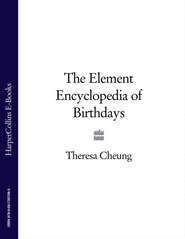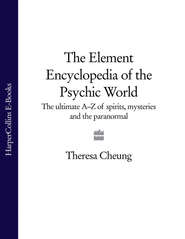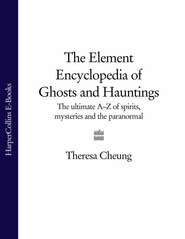По всем вопросам обращайтесь на: info@litportal.ru
(©) 2003-2024.
✖
The Element Encyclopedia of 20,000 Dreams: The Ultimate A–Z to Interpret the Secrets of Your Dreams
Автор
Год написания книги
2018
Настройки чтения
Размер шрифта
Высота строк
Поля
PLACES (#litres_trial_promo)
POSITIVE EMOTIONS (#litres_trial_promo)
PUZZLES, MYSTERIES AND DIFFICULTIES (#litres_trial_promo)
RELATIONSHIPS (#litres_trial_promo)
RELIGION (#litres_trial_promo)
REPTILES, FISH AND AMPHIBIANS (#litres_trial_promo)
SCHOOL AND WORK (#litres_trial_promo)
SENSES (#litres_trial_promo)
SEX (#litres_trial_promo)
SHAPES (#litres_trial_promo)
SICKNESS AND HEALTH (#litres_trial_promo)
SOUNDS (#litres_trial_promo)
SPACE AND SCIENCE (#litres_trial_promo)
SPIRITS AND GHOSTS (#litres_trial_promo)
STAGES OF LIFE (#litres_trial_promo)
SURREALISM AND FANTASY (#litres_trial_promo)
SYMBOLS (#litres_trial_promo)
TIME (#litres_trial_promo)
TRAVEL (#litres_trial_promo)
TREES (#litres_trial_promo)
VEGETABLES AND FRUIT (#litres_trial_promo)
WEATHER (#litres_trial_promo)
Index (#litres_trial_promo)
Acknowledgments (#litres_trial_promo)
Copyright (#litres_trial_promo)
About the Publisher (#litres_trial_promo)
PREFACE (#ulink_681763c1-afe4-548e-94dc-dd322571ac94)
‘What if you slept, and what if in your sleep you dreamed, and what if in your dream you went to heaven and there plucked a strange and beautiful flower, and what if when you awoke you had the flower in your hand? Ah, what then?’
Samuel Taylor Coleridge
A dream can sometimes feel incredibly real—as if the sensations experienced are actually happening—but then as we wake up to everyday reality we cannot make sense of anything and wonder what it all meant.
Most dream analysts believe that dreams are not meaningless but littered with messages from our unconscious. They are inner communications that, if heeded, have the potential to set us on the road to a richer, more fulfilling path in waking life. Sadly, many of us forget our dreams upon waking and this is a great loss. According to the Talmud: ‘A dream which is not interpreted is like a letter which is not read.’
If we are to remember, understand and work with the messages from our unconscious minds, we first need to learn how to interpret them. The Element Encyclopedia of 20,000 Dreams is an illuminating and comprehensive exploration of the symbols that appear in our dreamscape, and a rich source of information to help you unlock the messages, possibilities, richness and wisdom of your dream world. Use it to find out the fascinating things your dreams are trying to tell you!
HOW TO USE THIS BOOK (#ulink_6cf6e4e1-e1d5-55e2-9977-87ff08d550d5)
The Element Encyclopedia of 20,000 Dreams is arranged in three parts: the Introduction, the main section covering the Dreams themselves, and the Dream Directory.
The Introduction discusses the hows, whats and whys of sleep and dreams, the complexities of dream interpretation and what you need to know about unlocking the meaning of your dreams.
The Dreams is the main section of the book. Dream messages can be difficult to decipher until you have learned their secret language; this section will give you the key to your unconscious mind’s wealth. The entries are arranged in sixty thematic chapters, beginning with ACCIDENTS, ACTION AND ADVENTURES and finishing with WEATHER, and cover approximately 20,000 different dreams. Each chapter begins with a short introduction that talks about the kind of dreams covered in the section. The dream entries that follow are arranged in thematic order and you’ll also find cross references to relevant dream entries elsewhere in the book. Some chapters also contain an ‘A to Z’ of relevant dream objects and situations. You can dip into this massive resource to gain insight into a specific dream you may have had; for example, if you dreamt about a horse you can look for it in the chapter devoted to the theme of animals. Here you will be able to read about specific horse dreams, but at the same time you can cast your eye on entries covering similar or related animal topics which may throw light on your particular dream.
For ease of reference you may prefer to first turn to part three of the book: The Dream Directory. This lists every dream entry in the book in alphabetical order, so it is simple to look up specific dreams; it also functions as a cross-reference to other relevant entries.
INTRODUCTION (#ulink_f7a75bbc-0265-5e6c-8ccf-a9d447294cf5)
‘I dream, therefore I exist.’
J. August Strindberg
Dreams. They tantalize us with their mystery. What are they? Why do we have them? Where do they come from? What do they mean? Are they a preview of things to come or glimpses of the past? Are they a vital link to our inner world; a gift from our intuition? Can dreams lead us to important insights in our waking life, and help us decide which action to take and which path to follow?
The Hows, Whys and Whats of Sleep and Dreams
‘Sleep is the balm for hurt minds, nature’s great second course.’ William Shakespeare
Sleep is absolutely crucial for our physical, mental and emotional health and well-being. It is during sleep that we abandon conscious control of our physical body and the unconscious mind is allowed to roam free, giving rise to dreams.
Although we now know a lot more about dreams, their real purpose isn’t yet fully understood. It wasn’t until we approached the middle of the twentieth century, with the first electronic monitoring of the brain, that we began to get a clearer idea of the nocturnal adventures of the mind. For centuries it was thought that the purpose of sleep was to rest the body and the mind, but this reasoning was disproved when it was shown that both the body and mind are active during sleep. If sleep doesn’t rest the body or mind, then what is it for?
Sleep researchers may not yet have discovered the exact reason for sleep or dreams but they have discovered some fascinating things. For example, it seems that when we are asleep our brains are a bit like computers that are offline. This means they are not idle but are filing and updating the day’s activities. They take stock of your body and release a growth hormone to repair damaged tissues and stimulate growth, while the immune system gets to work on attacking any viral or bacterial infections that may be present. Some experts believe the brain also jettisons trivial information during sleep to prevent it becoming overburdened with unimportant information, but this explanation is perhaps too simplistic, as no memory can be totally eradicated.
The advent of space travel gave scientists the opportunity to prove that resting the body was not the main function of sleep. What they found instead was that prolonged periods of isolation decreased the need for sleep. In other words, the fewer stimuli received from people or external contacts during the day, the less sleep was required. It seems we have a sleep control center at the base of our brain linked with activity during wakefulness. When that gets overloaded we get tired, but if there have not been enough stimuli from the outside world, the sleep mechanism isn’t triggered. It seems, therefore, that boredom and lack of stimuli may account for many cases of insomnia. (Paradoxically, overstimulation also produces insomnia.)
The Four Stages of Sleep
‘Yet it is in our idleness, in our dreams, that the submerged truth sometimes comes to the top.’ Virginia Woolf
Perhaps the best way to understand sleep and dreams is to understand the brain. At the very start of the twentieth century it was found that the brain gave off electrical impulses, and by the 1920s scientists could measure brain waves. To obtain these readings, electrodes were attached to various parts of the head, the impulses being transformed onto electroencephalograms (EECs) on computer screens.








![The Dream Dictionary from A to Z [Revised edition]: The Ultimate A–Z to Interpret the Secrets of Your Dreams](/covers_185/48653382.jpg)


